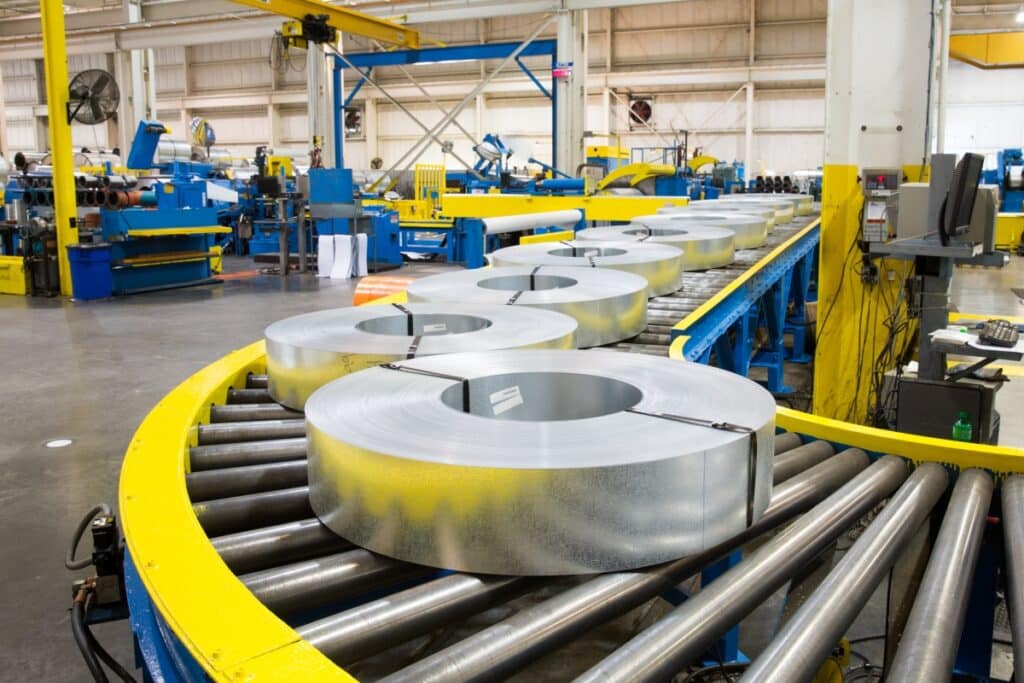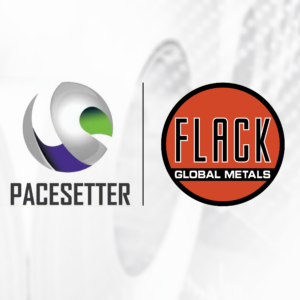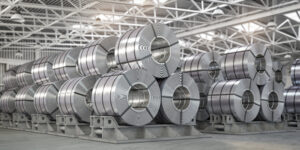Steel alloys have become the go-to metals for countless applications, from construction to jewelry and everything in between.
Steel mills coat coils by running them continuously through, literally, a bath of hot liquid zinc. This process, called galvanization, gives the steel a unique look, and more importantly, it extends the steel’s lifetime by providing excellent corrosion resistance. You can find galvanized steel in cars, buildings, appliances, HVAC systems, and much more.
In the world of flat roll steel, galvanized remains a top choice for corrosion protection, price, availability, and versatility. Galvanized steel is steel that has been applied with a protective zinc coating, which inhibits oxidation, rusting, and corrosion.
At Pacesetter, we offer many galvanized steel products, including:
-
Galvanized steel (with oil or a standard chemical treatment added for additional corrosion resistance). Regular galvanized is approximately 99.7% zinc coated.
-
Galvannealed offers a surface with more of a matte finish and more porosity. Its paint adhesion properties are excellent. The coating is composed of approximately 90% zinc and 10% iron.
-
Galvalume coatings are 55% aluminum, 43.5% zinc, and 1.5% silicon. Galvalume features excellent barrier-coating protection as well as galvanic protection.
-
Other options are a Zinc-Aluminum-Magnesium product and Aluminized, ranging from a nearly pure aluminum coating over the base steel to 89% aluminum and the balance silicon. Aluminized is popular where corrosion protection is required on hot applications such as dryer vents and mufflers. Electrogalvanized is a less common but available option.
-
Chemical Treatments (chem-treat) on these products covers as broad a spectrum as the products themselves.
-
Bonderized, Phosphatized, and Acrylic Coated: Provided with specific customer needs in mind, i.e., paintability or adhesion.
-
Standard Chrome-6 chem-treat, as well as RoHS compliant Chrome-3.
Pacesetter is a trusted national steel service center processor of galvanized steel. We provide or can provide comprehensive finishing services to meet your project requirements, including slitting, cut-to-length and blanking, perforating, embossing, and painting. We offer complete steel products and steel processing services to meet your exact project requirements. Learn everything you need to know about this type of steel, and give us a call or fill out a contact form for a quote!
What is Galvanized Steel?
Galvanized steel is a steel alloy that has been coated in zinc to protect the underlying metal from corrosive elements. There are many ways to galvanize steel, including:
-
Hot-dip galvanizing (hot-dipped galvanized or HDG): Steel coil is run through a bath of molten 99.5% pure zinc. The most common method for galvanization occurs on continuous galvanizing lines, where coils are welded together end-to-end and run through a bath of molten zinc. In industry parlance, regular HDG is referred to as “GI.”
-
Galvannealed: Produced on the same lines as GI, galvannealed is created by reheating the coil strip above the air knives to bond or alloy the zinc to the steel substrate. Most people know that galvannealed has a coating that is about 10% iron. However, iron is not added to the zinc bath. Instead, some of the aluminum content in the zinc bath is reduced and the iron reacts with the zinc in the reheating process to form an iron-zinc alloy. In industry parlance, galvannealed is abbreviated as “GA”.
-
Electrogalvanizing: A process quite different from hot-dip galvanizing, the zinc coating is applied to the steel in an electroplating process, where the anode is zinc, the cathode is steel, and the electrolyte is zinc sulfate. In other words, electrically applied rather than dipped in zinc. This process consumes a lot of electricity but leaves an excellent finish. Its main application has been in the automotive industry. In industry parlance, electrogalvanized steel is referred to as “EG.”
What Does Galvanized Steel Look Like?
Galvanized steel can have a spangle pattern (think old-school steel garbage cans), or the appearance can be ordered as temper passed or extra smooth, which smooths away the spangle appearance.
The History of Galvanized Steel
In 1742 the French chemist Melouin submitted a treatise to the French Royal Academy explaining how a zinc coating could be applied to iron, and it drew interest. Its first application was for kitchen utensils.
In 1780 an Italian, Luigi Galvani, discovered that electrical shock could be created with the contact of two different metals, setting the stage for the “electrogalv” process, and ultimately “galvanizing” was derived from his name.
One of the underrated scientific greats, Michael Faraday of England, discovered and wrote on metal alloys, magnetism, and electricity in the early 1800s, which contributed significantly to industrialized galvanization processes.
In 1837, Stanislas Sorel filed a patent in France to protect the iron from rust in larger batches, using a zinc bath – the precursor to the modern zinc bath on Galv lines. By 1850, British industry was consuming 10,000 tons of zinc per year for iron and steel coating.
Can Galvanized Steel be Painted?
Yes, galvanized steel can be painted. Prior to painting, it’s important to thoroughly clean the steel to remove any oil, dirt, or other contaminants that may be present, as these can prevent the paint from adhering properly.
In addition to proper cleaning, a primer should be applied before painting to ensure better adhesion of the paint to the steel. The primer must be compatible with the paint being used. For prepainted steel, this primer is a single component of the total paint system or spec.
Does Galvanized Steel Rust?
The galvanization process, which coats steel in a layer of zinc, prevents the underlying metal from rusting. Is galvanized steel rustproof? As long as the zinc coating remains undamaged, the rustproof nature of galvanized steel can last for decades.
How to Galvanize Steel
There are four ways to galvanize steel or coat it in a layer of zinc. Hot-dip galvanizing is the process of dipping finished steel into molten zinc. Galvannealing follows the hot-dipped process by heating the galvanized steel until the zinc coating and the steel alloy together. Pre-galvanizing is hot-dip galvanizing that takes place earlier in the steel production process. Electrogalvanizing uses electrical currents to bond zinc to steel.
How Long Does Galvanized Steel Last?
Galvanized steel can last for decades without showing signs of rust or corrosion in optimum environments. Of course, different applications and environments, as well as the thickness of the zinc coating itself, will yield different lifespans for galvanized steel. In saltwater conditions, galvanized steel can perform for up to 12 years without showing signs of corrosion. In ideal conditions, galvanized steel can resist rust up to 75 years or more.
Is Galvanized Steel Toxic?
Under normal conditions, galvanized steel is perfectly safe to come into contact with or even have contact with food. However, acidic foods should be kept away from galvanized steel because they can damage the zinc coating and expose the metal underneath. Like welding, extreme heat can also compromise the zinc creating zinc oxide, which is toxic to inhale.
Can You Solder Galvanized Steel?
Galvanized steel can be soldered together, but it’s advised to use rivets or a lock-seam to prevent failure to reinforce the connection. Like any soldering project, proper preparation is essential, and all standard safety precautions should be followed.
Is Galvanized Steel Magnetic?
Yes, most galvanized steel is magnetic because the steel base metal is magnetic.
Can You Weld Galvanized Steel?
Yes, you can weld galvanized steel, but it takes extra prep work to keep the process safe for the welder and maintain the corrosive-resistant nature of the galvanized steel. Any surface welded should have the zinc removed first. Welding zinc creates zinc oxide, a gas that isn’t safe for inhaling. Once the weld is complete, the weld must be pre-galvanized with zinc to maintain the corrosive-resistant nature of the galvanized metal.
Can You Burn Galvanized Steel?
Galvanized metal should not be used for fire pits or in circumstances with excessively high heat. This is due to the zinc coating on the base metal. High temperatures can give off zinc oxide, which is toxic when inhaled.
Applications & Advantages
Today, galvanized steel has an enormous array of usages. You encounter it in some way, shape, or form every day. It’s used in construction products, HVAC systems, roofing, automotive, agriculture, power transmission, hardware, piping, and much more.
Why galvanized and not cheaper uncoated steel or other coatings or materials?
-
Low long-term cost. While the initial cost of galvanizing is higher than alternative coatings or no coating, it’s often more economical in the long term because of its longevity in the field and a high degree of protection.
-
Low short term cost: Stainless steel, for example, is also used where corrosion protection is needed. However, only in the most demanding or specialized applications (food, medical) would the high cost of stainless steel justify its use over galvanized steel.
-
Long life: The life expectancy of galvanized coatings can exceed 60 years in many environments and 20 years, even in severe urban and coastal applications.
-
Galvanic Protection/Barrier Protection: The base steel is protected by zinc, zinc/alloy coating elements. The life expectancy over uncoated steel is multiplied many times over.
-
Adaptable/Practical: Weldability, paintability, formability are all there, and galvanized coatings are compatible with grades from highly formable EDDS to ultra-high-strength steels.
-
Available: Most major steel mills make galvanized steel.
Need Galvanized Steel For Your Next Project?
Pacesetter is a recognized leader in the service center sector in the purchasing, processing, efficiency, and quality aspects of galvanized steel. If you need galvanized steel manufactured and processed for your next project, contact us below to coordinate with one of our experts. We have service centers in Atlanta, Chicago, and Houston, and our headquarters is located in Kennesaw, Georgia. We can discuss your project needs and provide you with the galvanized steel you need at the best price.
- Galvanized steel (with oil or a standard chemical treatment added for additional corrosion resistance). Regular galvanized is approximately 99.7% zinc coated.
- Galvannealed offers a surface with more of a matte finish and more porosity. Its paint adhesion properties are excellent. The coating is composed of approximately 90% zinc and 10% iron.
- Galvalume coatings are 55% aluminum, 43.5% zinc, and 1.5% silicon. Galvalume features excellent barrier-coating protection as well as galvanic protection.
- Other options are a Zinc-Aluminum-Magnesium product and Aluminized, ranging from a nearly pure aluminum coating over the base steel to 89% aluminum and the balance silicon. Aluminized is popular where corrosion protection is required on hot applications such as dryer vents and mufflers. Electrogalvanized is a less common but available option.
- Chemical Treatments (chem-treat) on these products covers as broad a spectrum as the products themselves.
- Bonderized, Phosphatized, and Acrylic Coated: Provided with specific customer needs in mind, i.e., paintability or adhesion.
- Standard Chrome-6 chem-treat, as well as RoHS compliant Chrome-3.
What is Galvanized Steel?
Galvanized steel is a steel alloy that has been coated in zinc to protect the underlying metal from corrosive elements. There are many ways to galvanize steel, including:- Hot-dip galvanizing (hot-dipped galvanized or HDG): Steel coil is run through a bath of molten 99.5% pure zinc. The most common method for galvanization occurs on continuous galvanizing lines, where coils are welded together end-to-end and run through a bath of molten zinc. In industry parlance, regular HDG is referred to as “GI.”
- Galvannealed: Produced on the same lines as GI, galvannealed is created by reheating the coil strip above the air knives to bond or alloy the zinc to the steel substrate. Most people know that galvannealed has a coating that is about 10% iron. However, iron is not added to the zinc bath. Instead, some of the aluminum content in the zinc bath is reduced and the iron reacts with the zinc in the reheating process to form an iron-zinc alloy. In industry parlance, galvannealed is abbreviated as “GA”.
- Electrogalvanizing: A process quite different from hot-dip galvanizing, the zinc coating is applied to the steel in an electroplating process, where the anode is zinc, the cathode is steel, and the electrolyte is zinc sulfate. In other words, electrically applied rather than dipped in zinc. This process consumes a lot of electricity but leaves an excellent finish. Its main application has been in the automotive industry. In industry parlance, electrogalvanized steel is referred to as “EG.”
What Does Galvanized Steel Look Like?
Galvanized steel can have a spangle pattern (think old-school steel garbage cans), or the appearance can be ordered as temper passed or extra smooth, which smooths away the spangle appearance.The History of Galvanized Steel
In 1742 the French chemist Melouin submitted a treatise to the French Royal Academy explaining how a zinc coating could be applied to iron, and it drew interest. Its first application was for kitchen utensils. In 1780 an Italian, Luigi Galvani, discovered that electrical shock could be created with the contact of two different metals, setting the stage for the “electrogalv” process, and ultimately “galvanizing” was derived from his name. One of the underrated scientific greats, Michael Faraday of England, discovered and wrote on metal alloys, magnetism, and electricity in the early 1800s, which contributed significantly to industrialized galvanization processes. In 1837, Stanislas Sorel filed a patent in France to protect the iron from rust in larger batches, using a zinc bath – the precursor to the modern zinc bath on Galv lines. By 1850, British industry was consuming 10,000 tons of zinc per year for iron and steel coating.Can Galvanized Steel be Painted?
Yes, galvanized steel can be painted. Prior to painting, it’s important to thoroughly clean the steel to remove any oil, dirt, or other contaminants that may be present, as these can prevent the paint from adhering properly. In addition to proper cleaning, a primer should be applied before painting to ensure better adhesion of the paint to the steel. The primer must be compatible with the paint being used. For prepainted steel, this primer is a single component of the total paint system or spec.Does Galvanized Steel Rust?
The galvanization process, which coats steel in a layer of zinc, prevents the underlying metal from rusting. Is galvanized steel rustproof? As long as the zinc coating remains undamaged, the rustproof nature of galvanized steel can last for decades.How to Galvanize Steel
There are four ways to galvanize steel or coat it in a layer of zinc. Hot-dip galvanizing is the process of dipping finished steel into molten zinc. Galvannealing follows the hot-dipped process by heating the galvanized steel until the zinc coating and the steel alloy together. Pre-galvanizing is hot-dip galvanizing that takes place earlier in the steel production process. Electrogalvanizing uses electrical currents to bond zinc to steel.How Long Does Galvanized Steel Last?
Galvanized steel can last for decades without showing signs of rust or corrosion in optimum environments. Of course, different applications and environments, as well as the thickness of the zinc coating itself, will yield different lifespans for galvanized steel. In saltwater conditions, galvanized steel can perform for up to 12 years without showing signs of corrosion. In ideal conditions, galvanized steel can resist rust up to 75 years or more.Is Galvanized Steel Toxic?
Under normal conditions, galvanized steel is perfectly safe to come into contact with or even have contact with food. However, acidic foods should be kept away from galvanized steel because they can damage the zinc coating and expose the metal underneath. Like welding, extreme heat can also compromise the zinc creating zinc oxide, which is toxic to inhale.Can You Solder Galvanized Steel?
Galvanized steel can be soldered together, but it’s advised to use rivets or a lock-seam to prevent failure to reinforce the connection. Like any soldering project, proper preparation is essential, and all standard safety precautions should be followed.Is Galvanized Steel Magnetic?
Yes, most galvanized steel is magnetic because the steel base metal is magnetic.Can You Weld Galvanized Steel?
Yes, you can weld galvanized steel, but it takes extra prep work to keep the process safe for the welder and maintain the corrosive-resistant nature of the galvanized steel. Any surface welded should have the zinc removed first. Welding zinc creates zinc oxide, a gas that isn’t safe for inhaling. Once the weld is complete, the weld must be pre-galvanized with zinc to maintain the corrosive-resistant nature of the galvanized metal.Can You Burn Galvanized Steel?
Galvanized metal should not be used for fire pits or in circumstances with excessively high heat. This is due to the zinc coating on the base metal. High temperatures can give off zinc oxide, which is toxic when inhaled.Applications & Advantages
Today, galvanized steel has an enormous array of usages. You encounter it in some way, shape, or form every day. It’s used in construction products, HVAC systems, roofing, automotive, agriculture, power transmission, hardware, piping, and much more. Why galvanized and not cheaper uncoated steel or other coatings or materials?- Low long-term cost. While the initial cost of galvanizing is higher than alternative coatings or no coating, it’s often more economical in the long term because of its longevity in the field and a high degree of protection.
- Low short term cost: Stainless steel, for example, is also used where corrosion protection is needed. However, only in the most demanding or specialized applications (food, medical) would the high cost of stainless steel justify its use over galvanized steel.
- Long life: The life expectancy of galvanized coatings can exceed 60 years in many environments and 20 years, even in severe urban and coastal applications.
- Galvanic Protection/Barrier Protection: The base steel is protected by zinc, zinc/alloy coating elements. The life expectancy over uncoated steel is multiplied many times over.
- Adaptable/Practical: Weldability, paintability, formability are all there, and galvanized coatings are compatible with grades from highly formable EDDS to ultra-high-strength steels.
- Available: Most major steel mills make galvanized steel.
Need Galvanized Steel For Your Next Project?
Pacesetter is a recognized leader in the service center sector in the purchasing, processing, efficiency, and quality aspects of galvanized steel. If you need galvanized steel manufactured and processed for your next project, contact us below to coordinate with one of our experts. We have service centers in Atlanta and Chicago, a joint venture in Houston, and our headquarters is located in Kennesaw, Georgia. We can discuss your project needs and provide you with the galvanized steel you need at the best price.




